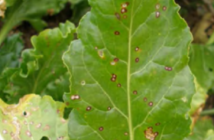The Plant & Microbial Genomics Group at TGAC has been awarded £100k towards the identification of the sources of infection and reinfection of the sugar beet crop across the UK.
Sugar production from sugar beet accounts for 20 per cent of the world’s supply. Erysiphe betae, a sugar beet powdery mildew can cause sugar yield losses of up to 20 per cent.
Presently, to reduce the impact of E. betae, the main methods are fungicidal treatments and a range of partially resistant varieties. However, despite annual surveys for E. betae prevalence little is known about the disease’s diversity, its source of infection and strains that re-infect after fungicidal treatment.
Following a successful proposal, titled: “Discovering the source of sugar beet infection and re-infection by Erysiphe betae”, the British Beet Research Organisation (BBRO) granted TGAC the funding to, quantify the diversity of the UK E. betae species, determine the source of infection of the sugar beet crop, and identify the effects of fungicidal application on pathogen genetic diversity.
The research project will use a hundred E. betae genome sequences from both an agricultural and wild setting, contributed via the BBRO and wider sugar beet industry, and will analyse the pathogen to design genetic markers that will be used in a rapid detection technology to identify infection in sugar beet species.
This will be accompanied by the generation of a draft genome assembly of a secondary beet pathogen, the rust Uromyces beticola, which will allow the research team to gain further insight into the sugar beet pathogen, answering questions regarding its size and complexity, and informing potential follow-up studies.
Dr Mark McMullan, Population & Evolutionary Biologist in the Plant & Microbial Genomics Group at TGAC, said: “Evolution of powdery mildew in the wild may drive adaptation to crop hosts and cause losses in agriculture. By analysing the population genetics of pathogens that span both wild and agricultural ecosystems we hope to shed light on the causes of sugar beet infection and also on the causes of agricultural host-pathogen evolution.”
Priorities in the sugar beet industry are to protect and promote sugar beet yield and performance and an important part of this objective is to decrease yield losses caused by fungal pathogens.
Currently, the main treatments for E. betae, are the triazole/strobilurin fungicides which are currently under scrutiny, due to concerns of their effects on the human endocrine system.
Alternatives to widespread fungicide treatment are: targeted fungicidal applications and optimal deployment of current resistant cultivars via improved disease forecasting and identification of pathogen reservoirs.
Dr Matthew Clark, Plant & Microbial Genomics Group Leader, said: “Wild plants can often be a reservoir of agricultural diseases especially important if it’s where they complete their life cycle. A better understanding the biology of E. betae and how modern agriculture is affecting it could enable better land management to minimise yield loss, pesticide use and harm to the environment.”
Understanding the diversity of a pathogen population can improve development of resistant cultivars, facilitate treatment programmes and allow the identification of new infectious strains. Studying the diversity of E.betae strains will inform resistance trials and allow for the future development of targeted treatment of possible virulent strains.
Identification of genetic variation will enable the researchers to design DNA markers for an infield detection system using an isothermal DNA amplification system from TwistDx as a diagnostic tool. Knowing the source of the E. betae agricultural outbreak will inform surveillance and treatment decisions to reduce fungicide treatment. By analysing E. betae species that infect both before and after fungicidal treatment will identify those that are more resistant to current treatment strategies.
E. betae genome sequencing is especially favourable because of the recent release of the sugar beet genome sequence. Together, these genomic resources are valuable tools for the future discovery of novel resistance genes for E. betae infection and improved sugar beet varieties.
Dr Lawrence Percival-Alwyn, Research Associate in Plant & Microbial Genomics at TGAC, added: “Currently it’s unknown how fungicidal treatment affects the success of different E.betae strains. By sequencing strains that infect prior to and those that re-emerge following fungicidal treatment, we hope to identify those strains that are more resistant to current treatments. With greater insight into the mode of infection and progression of E. betae on the sugar beet crop, combined with strain specific identification in the form of a diagnostic assay, the ultimate goal is to inform disease management strategy and potentially introduce targeted treatment programmes.”
TGAC’s research has the potential to lead to the development of markers for an infield diagnostic test for Erysiphe betae. Scientists will develop two types of DNA-based diagnostic tests, lab-based and infield based test kits using the TwistDx technology.
TGAC is strategically funded by BBSRC and operates a National Capability to promote the application of genomics and bioinformatics to advance bioscience research and innovation.



